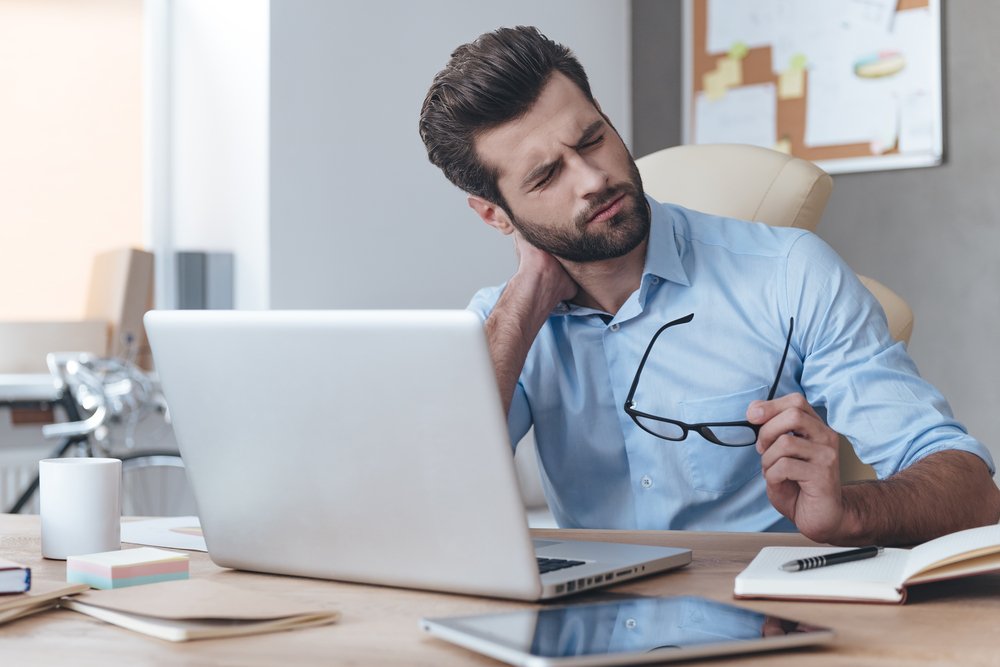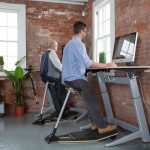By Lana Barhum
“Tech neck,” also called “text neck,” is the term for chronic neck pain associated with a cervical spine (neck) curvature. It occurs when the neck is tilted forward for long periods while using electronic devices like computers, tablets, and smartphones.1 Over time, the strain on the neck can damage muscles and misalign the spine.
This strain could lead to poor posture, inflamed and painful joints, pinched nerves, or herniated discs.1 Tech neck might have additional effects beyond the neck, including lower back pain, headache, jaw problems, and cosmetic effects.
One 2019 survey of college students found those who spent more time on their phones had more neck pain than those who spent less time on their devices.2
Neck pain from using electronic devices led many students to seek medical care, including emergency room visits, leading the researchers to conclude that the long-term use of such devices would burden healthcare systems.
This article will cover the symptoms of tech neck, how to find relief, targeted treatments, management, and more.
Tech Neck: Do I Have the Symptoms?
Research shows that tech neck can lengthen neck and shoulder muscles and shorten chest muscles, leading to a hunched posture.3 This posture puts pressure on the neck and causes the shoulders to slump. The misalignment could cause shoulder and neck pain and stiffness.

If pressure on the spine leads to a pinched nerve, symptoms may include:4
- Headaches
- Sharp, achy, or burning pain
- Pain radiating from the neck
- Worsened pain with some movements, such as turning the head
- A pins-and-needles feeling
- A feeling of weakness during activity
- Numbness
- Feeling that the arm or hand has fallen asleep
- Upper back tension
- Pain that radiates into the middle and lower back
Tech neck might also be linked to temporomandibular disorders (TMD)—pain or dysfunction in the jaw joints and muscles. One study published in 2015 in BioMed Research International observed tender points in the neck, which were commonly seen in people with TMD.5 Here, neck pain was found to be associated with TMD 70% of the time.
Tech neck and a front forward posture can also affect the rotator cuff—the muscles and tendons surrounding the shoulder joint.6 Over time, a forward posture can lead to rotator cuff tendonitis—irritation and inflammation (the body’s response to harmful stimuli, which leads to tenderness and swelling) of some of the muscles and tendons in the shoulder. People with rotator cuff injuries might be at an increased risk for tech neck.
Tech neck can also lead to cervical kyphosis—the loss of the natural C-shaped curve of the neck.7 The curve will straighten out or be reversed. It does not always cause symptoms, and some straightening of the spine is normal.
Other Effects of Tech Neck
Tech neck has additional effects, including cosmetic problems, fatigue, and reduced work productivity.
Cosmetic problems linked to tech neck include wrinkles, a double chin, and neck sagging.8 This is because it can lead to collagen loss and muscle and skin laxity (loose and sagging skin). In addition, the repetitive motion of the neck when using technology can contribute to the folding of the skin.
{What Is Collagen? Collagen is an abundant and vital protein found in connective tissue, skin, muscles, bones, cartilage, tendons, and ligaments.9 It is also found in the organs, intestinal linings, and blood vessels.}
Looking down at your phone, tablet, or computer screen can put extra strain on the neck muscles, increase fatigue, and reduce productivity.10
One 2017 study examined how musculoskeletal pain in the neck, back, and shoulders affects fatigue levels and productivity of office workers.10 That study found neck, lower back, and shoulder pain has a nearly equal effect on total fatigue and concentration and focus aspects of productivity.
Causes and Risk Factors
Research primarily links tech neck to mobile, handheld devices.11 However, other activities and risk factors can contribute to or worsen tech neck.
Smartphones are a common problem because they force the user to tilt the head forward and down, which can cause neck strain and poor posture. Computer use (laptops and desktops), tablets, and video gaming can also contribute to tech neck symptoms because they can promote a forward head position.
Some people may be at an increased risk for tech neck. This includes people who have preexisting disc problems, a shoulder or rotator cuff issue, neck arthritis, or a previous neck injury or neck surgery.12 Tech neck can also worsen these conditions and cause more pain and joint, nerve, and muscle damage.
Quick Tech Neck Relief
If your neck and shoulders are sore and stiff at the end of the day, it is a good idea to look at your tech habits. Here are some ways to get quick relief when dealing with tech neck symptoms.
SET OF EXERCISES №1 TO IMPROVE POSTURE. ROUND BACK (SLOUCHING)
Take Breaks
Most of the time, tightness and stiffness symptoms from tech neck occur from sitting in the same position for an extended period.13 A stretching break can help alleviate tech neck symptoms quickly.
Aim to take stretch breaks from your phone, tablet, or computer to move the neck and head at least every 30 minutes. In addition to stretching the neck, try to get up and move around at least once every hour during your workday so that you work a variety of muscles.
Fix Your Posture
Good posture aligns the ears, shoulders, and hips in a straight line, giving the spine an S shape with three front-to-back curves.14 These curves help absorb stress and impact on the back.
While sitting, sit with your hips and knees at the same level in a chair that is low enough to place both your feet flat on the floor and your knees nearly level with the hips.14
Shoulders should be kept back and down, with the chin back, the belly in, and the lower back supported. A small pillow, lumbar roll, or rolled-up towel can offer extra support for the curve of the lower back.
When it comes to proper posture and electronic devices, hold devices at eye level while standing or sitting.15 The device should be within your line of sight. You might also consider using devices with larger screens and texting with both hands.
Staring down at your screen for an extended period causes muscle tension and tightness. A heating pad can move blood in the affected muscle areas to relax the muscles and relieve pain.16
A heating pad that covers the neck and shoulders can be worn and used at any time the neck experiences pain and other tech neck symptoms.
Self-Massage
Self-massage can improve blood flow in tight neck and shoulder muscle areas.17 For pain relief, you can use your fingers, a massage ball, or a massage gun.
The amount of pressure used will depend on what feels comfortable. Stop or reduce pressure in the affected area if you feel sharp pain or tingling.
Over-the-Counter (OTC) Pain Relievers
OTC oral pain-relieving medications for tech neck include Tylenol (acetaminophen) and nonsteroidal anti-inflammatory drugs (NSAIDs) like Advil (ibuprofen) or Aleve (naproxen). NSAIDs can also help reduce inflammation and stiffness.
OTC topical pain relief creams, including salicylates, counterirritants, anesthetics, topical NSAIDs, and hydrocortisone, can help to improve neck symptoms, such as numbness, pain, muscle tension, swelling, and inflammation.18
Exercises to Correct Tech Neck
If you experience minor symptoms of tech neck, some simple exercises can quickly address them. These can relieve mild pain and stop soreness and stiffness. Discuss these exercises with a healthcare provider if you have any movement restrictions, recent injury, or chronic bone or muscle conditions.

Such exercises include:19
Chin Retraction
Perform a chin retraction as follows:
- Pull your chin backward while looking directly ahead. You should feel a double chin forming under the jaw. It may help to practice this in front of a mirror.
- Repeat this forward/backward exercise 10 times every hour or two.
- You might also want to perform this lying down with a small ball or pillow behind your head to give you feedback on how to do it accurately.
Upper Trap Stretch
This exercise helps to relieve tension in the muscles that span the back of your neck and shoulders. To stretch the right side:
- Place the right hand on the waist or lower back and tilt the head to the left.
- Place the left hand on the top of the head and gently pull left until you feel a comfortable stretch. Hold for 20 to 30 seconds.
- Repeat on your left side.
Standing Scapular Retraction
Standing scapular retraction requires the following movements:
- Start by standing with your feet apart.
- Retract your shoulder blades, drawing them into the center of your back without shrugging your shoulders. Your shoulders should not move up toward your ears.
- Hold the position for two to three seconds and release.
- Repeat 10 times.
SET OF EXERCISES №3 TO IMPROVE POSTURE. FLAT BACK
Targeted Treatments to Correct Tech Neck
For most people, tech neck is not a severe condition. However, some symptoms or medical conditions might require you to seek medical attention.
You should see a healthcare provider for:20
- Severe or worsening pain or headaches
- Neck pain with dizziness
- Continued pain after conservative treatment, such as breaks, stretches, and OTC pain relievers
- Weakness, numbness, tingling, and a loss of feeling in the arms or hands
- Pain that affects your sleep
- Neck pain when you have a prior injury, disc problem, cervical arthritis, or other neck issue
Tech neck that does not improve with conservative at-home treatments can be treated with the following:21
- Physical therapy: A physical therapist can help create a stretching and exercise program to help manage and treat neck and shoulder pain, tension, and stiffness.
- Chiropractic care: A 2021 Journal of Clinical Medicine review found that chiropractic manipulation can treat acute neck pain.22 Chiropractic treatment can effectively treat neck pain, especially when combined with physical therapy and medication.
- Additional alternative pain management techniques: Acupuncture and deep-tissue massage might also offer pain relief related to tech neck. However, research on these two pain management methods has shown mixed results.1
- Prescription pain relief: Your healthcare provider can prescribe oral or injected medicines, including prescription NSAIDs, muscle relaxers, and corticosteroids, to block pain and manage muscle pain and spasms.21 If pain is minor, they may recommend OTC NSAIDs and topical treatments instead.
- Surgery: While minor tech neck does not require surgery, if you have herniated discs, spinal cord problems, bone spurs, or fractures, your healthcare provider may recommend surgery.
- Prevention: Treatment can also focus on preventing recurrences and promoting your long-term spine health. This typically involves improving posture, regular exercises for supporting the neck and upper back, and an ergonomic workspace, which can include a standing desk, monitor arms, and an ergonomic chair.

Outlook for Tech Neck
If tech neck is caught early and is mild, it can resolve, provided you manage it with the following measures:
- Improved posture
- Stretching
- Limited screen time
- An ergonomic workstation
- OTC pain relief
More serious symptoms may need additional treatment.
The time it takes you to heal from tech neck will depend on the severity of symptoms, your overall health, treatment methods, lifestyle changes, and your commitment to treatment and self-care. If you end up with a severe case that leads to nerve impingement, a disc problem, or another health issue, you will take much longer to heal and will need more aggressive treatment options.23
Screentime Suggestions to Manage Tech Neck
It is a good idea to take breaks from screen time to help avoid pain and other symptoms linked to tech neck. Here are some strategies that might help:24

- Make use of time after work: Your job may require you to spend a lot of your day in front of a screen. If that is the case for you, take the opportunity to use nonwork hours doing activities that better your physical and mental health instead, such as taking a walk, listening to music, or doing yoga.
- Space out tasks: Spacing out digital tasks throughout the day can help you manage and reduce your screen time. Set reminders on a smartphone, and once you get on your laptop or other electronic device, set a timer alerting you to get off the device down.
- Turn off notifications: Consider turning off email and calendar notifications so you are not tempted to get on your phone or other device often. You may find yourself on your device longer than necessary, which could be enough time to cause neck strain.
- Avoid screen time during meals: Poor neck posture is difficult to avoid if you are engaging with a screen while eating. Focus on your meal and dining companions rather than on a screen.
- Take breaks: If you are required to spend long periods in front of a computer screen, take breaks every 30 minutes or so. Get away from the screen, move around, and stretch. Moving around and getting away for a few minutes might also help you manage your focus and concentration once you return to your work.
Summary
Tech neck is becoming a common problem with the widespread use of electronic devices. It can lead to chronic neck and shoulder pain, soreness, and stiffness. It is mainly caused by a poor, forward, or slumped posture that stresses the neck muscles.
Fortunately, tech neck is preventable by practicing correct posture while working on a computer and keeping your phone at eye level while you use it to text or scroll online. Take breaks and stretch your neck, back, and shoulder muscles to prevent and alleviate symptoms of tech neck.
Tech neck is usually not a serious problem, and most people can successfully treat symptoms with self-care and lifestyle changes. Even with more severe symptoms, the outlook for tech neck can still be good. It may just require more aggressive therapies.
You should contact your healthcare provider if you have experienced more severe or preexisting neck problems, including neck arthritis and disc issues. They can examine you and determine a treatment plan, which may include physical therapy, oral and injectable medications, chiropractic care, or surgery for a more severe problem.
Barhum is a freelance medical writer with 15 years of experience with a focus on living and coping with chronic diseases.
Video: “Exercises for the Rehabilitation of Posture Disorders”
SET OF EXERCISES №4 TO IMPROVE POSTURE. SPINE CURVATURE (SCOLIOSIS)
For additional information about exercises for the rehabilitation of Posture disorders you can watch a video demonstrating exercises and rehabilitation recommendations.

CHECK OUT THE DEMO VERSION OF OUR SETS OF EXERCISES FOR THE REHABILITATION OF POSTURE DISORDERS ON YOUTUBE
Our website presents the following sets of exercises for the rehabilitation of Posture disorders:





